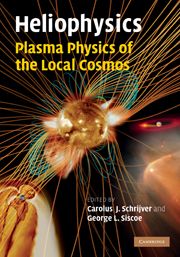Book contents
- Frontmatter
- Contents
- Preface
- 1 Prologue
- 2 Introduction to heliophysics
- 3 Creation and destruction of magnetic field
- 4 Magnetic field topology
- 5 Magnetic reconnection
- 6 Structures of the magnetic field
- 7 Turbulence in space plasmas
- 8 The solar atmosphere
- 9 Stellar winds and magnetic fields
- 10 Fundamentals of planetary magnetospheres
- 11 Solar-wind– magnetosphere coupling: an MHD perspective
- 12 On the ionosphere and chromosphere
- 13 Comparative planetary environments
- Appendix I Authors and editors
- List of illustrations
- List of tables
- References
- Index
6 - Structures of the magnetic field
Published online by Cambridge University Press: 05 August 2013
- Frontmatter
- Contents
- Preface
- 1 Prologue
- 2 Introduction to heliophysics
- 3 Creation and destruction of magnetic field
- 4 Magnetic field topology
- 5 Magnetic reconnection
- 6 Structures of the magnetic field
- 7 Turbulence in space plasmas
- 8 The solar atmosphere
- 9 Stellar winds and magnetic fields
- 10 Fundamentals of planetary magnetospheres
- 11 Solar-wind– magnetosphere coupling: an MHD perspective
- 12 On the ionosphere and chromosphere
- 13 Comparative planetary environments
- Appendix I Authors and editors
- List of illustrations
- List of tables
- References
- Index
Summary
Preamble
One goal this book pursues is to identify phenomena throughout the heliosphere that can be said to be universal. An excellent example of a universal subject is the morphology of magnetically defined structures. The heliosphere is full of distinctive magnetic forms that recur in widely different places. What they are and why this is so are questions we take up here. As a first stab at distinguishing magnetically defined structures, we put them into three groups: current sheets, of which the heliospheric current sheet (HCS) is the largest example; flux tubes, with sunspots as a prototype; and cells, in which we include cavities such as magnetospheres. These three classes make up the common forms of heliophysical magnetic structure that exist on MHD time and distance scales (we are not concerned here with kineticscale structures that inhabit the dissipation range of turbulence). Our tasks are to explain why these magnetic structures arise naturally and to describe examples of each. It is important to note that these structures are idealized mental constructs to approximate a real world; we are trying to describe a continuum in black-and-white terms. We should realize that current sheets are not mathematical planes, flux tubes are surrounded by other fields, and cells are leaky in the real world. Nevertheless, these abstractions should help us to think and communicate.
That magnetically defined structures in the heliosphere have been seen to take common forms has led people to recognize over time that there actually exists such a thing as the magnetic organization of cosmic matter (as described, for example, in the NRC report “Plasma physics of the local cosmos”, 2001, after which this volume is named).
- Type
- Chapter
- Information
- Heliophysics: Plasma Physics of the Local Cosmos , pp. 139 - 162Publisher: Cambridge University PressPrint publication year: 2009
- 3
- Cited by



